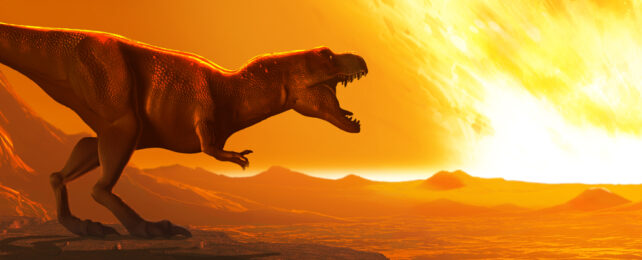The explosive end of non-avian dinosaurs is the most infamous blow to life on Earth. But there's long been hints that the asteroid may not be the main culprit behind this mass extinction, just the most spectacular isolated contribution.
Before this dramatic event, 66 million years ago, toxic winds of change were already brewing in the air.
A new analysis by an international team of researchers has added evidence to claims that the world prior to the asteroid blow was anything but paradise, with measures of sulfur in the atmosphere reaching critical levels.
Together with other studies on levels of mercury, the research provides a signature of volcanic activity strong enough to cause significant climate disruptions.
In 1991, the timing of this volcanic activity had been dismissed as too early to be behind the mass extinction event but more recent studies demonstrate it's possible the timing was close enough to be significant.
"Our data suggest that volcanic sulfur degassing from such activity could have caused repeated short-lived global drops in temperature," University of Oslo geoscientist Sara Callegaro and colleagues write in their paper.
The team examined rocks from the Deccan Traps – one of the largest volcanic features – in what's now West India. They applied a new technique they developed for measuring sulfur concentrations.
Models suggest sustained sulfur emissions from the Deccan Traps were enough to substantially alter the global climate. This volcanic region alone released a staggering one million cubic kilometers of molten rock.
What's more, formation of the highly concentrated sulfur containing lava at Thakurvadi to Bushe, within the region, coincides with the cooling Cretaceous climate, the team notes.
While much of the basalt in the area is generally low in sulfur, this could indicate the climate – cooling molecule was slowly released into the atmosphere from the hardened magma following eruptions.
As a result global temperatures could have plummeted in bouts of up to 10°C, between rapid recovery periods, within 100,000 years before the Chicxulub meteor delivered that final blow.
"Our research demonstrates that climatic conditions were almost certainly unstable, with repeated volcanic winters that could have lasted decades, prior to the extinction of the dinosaurs, " explains McGill University geochemist Don Baker.
"This instability would have made life difficult for all plants and animals and set the stage for the dinosaur extinction event."
Fossilized bone fragments and thousands of eggshell remnants have suggested a global decline in non-avian dinosaur species over such a prolonged time period.
But these declines have been contradicted by other studies, continuing a long-standing and sometimes bitter scientific debate between the asteroid and volcano theories. Some researchers suggest the asteroid may have triggered greater activity from the Deccan Traps, others claim the volcanic activity may have even helped life recover from the asteroid strike.
The argument for pulses of eruptions does seem to be stacking up and volcanoes are, after all, what brought three quarters of all life on Earth to an end during the previous mass extinction.
"Deccan Traps volcanism set the stage for a global biotic crisis, repeatedly deteriorating environmental conditions by forcing recurring short volcanic winters," the team concludes.
Their research was published in Science Advances.
